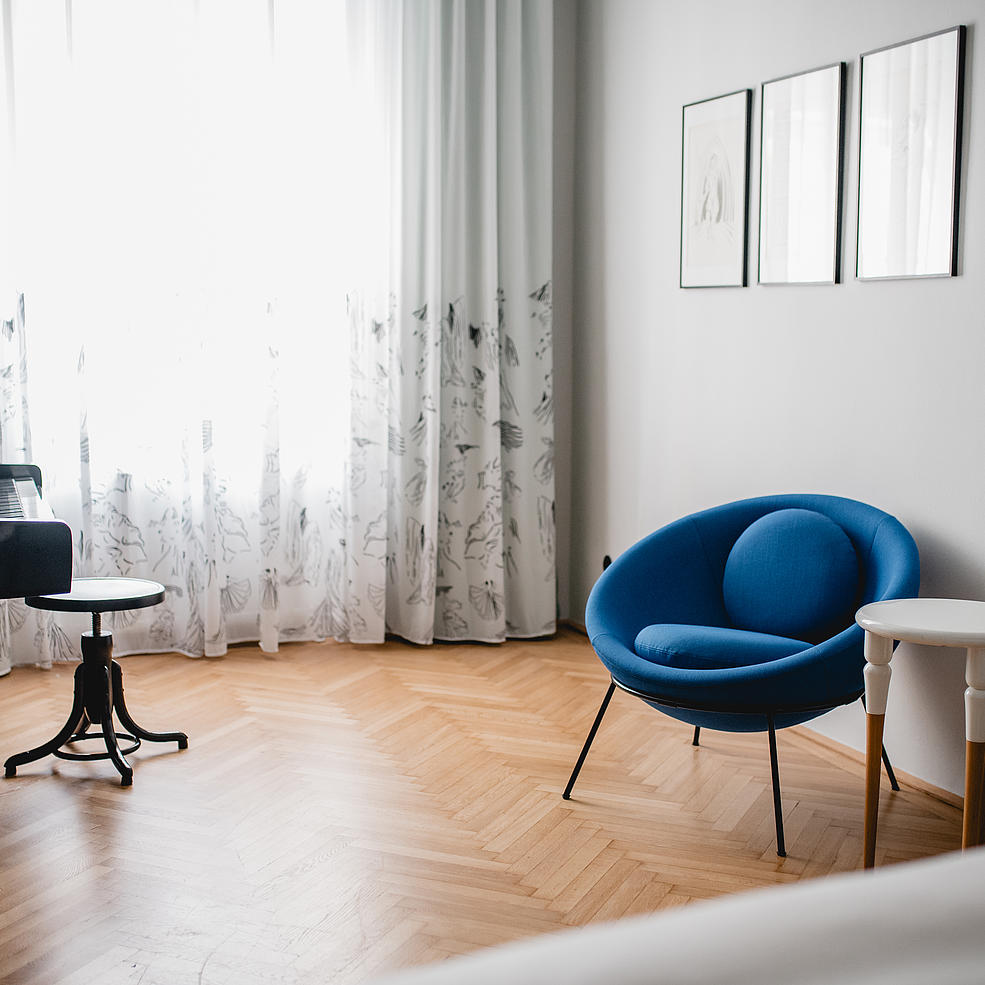
Hotel
Talk
A conversation with Antonella Amesberger about #79
Antonella, we've had the pleasure before. How did our collaboration come about for our Grete Wiesenthal Suite?
Indeed, during my studies, I had the opportunity to design the hotel's former Library Suite as an intern with Lena Hoschek. Ten years later, I returned as an architect for breakfast in the Altstadt Salon and was delighted to see so many familiar faces again. With a brand-new business card, I sent my regards to Otto, and a few months later, the phone rang.
What were the first steps in the concept development for this room? How did you approach the engagement with Grete Wiesenthal?
The first step was actually to pick up the phone: Lucie Horná, a ballet dancer with whom I had previously implemented an "Art in Reconstruction" project, gave me insights into the revolutionary Wiesenthal technique and showed me recordings of the dances. Only then could I understand the spherical posture of Grete Wiesenthal: The upper body is bent far backwards, the arms are wide open, and now turning in large steps. I was fascinated by the life story of the Wiesenthal sisters and researched the Viennese dance modernism. Wiesenthal's proximity to the Wiener Werkstätte led me to the MAK archive. Another source of inspiration was the extensive visual material: wide dresses, open hair, the ecstatic revolution of the waltz. The design concept was meant to be light, joyful, and dynamic, conveying the unity of body, dance, and music: The mirror on the ceiling of the salon invites guests to assume the protagonist's dance posture and experience the solo spinning moment for themselves. I abstracted historical photos of the dancing Grete Wiesenthal using line drawings and thus designed a dynamic rapport for flowing curtains and upholstery fabrics. The approach in two words: research and experiment!


Our designers are always asked to also think about an interpretation of the Viennese way of life and to reflect it. What, for you, is particularly Viennese about the Grete Wiesenthal Suite? What do you associate with the Viennese way of life?
The given layout of the Viennese Gründerzeit building from 1899 is fundamentally Viennese. The sequence of high rooms, each centrally accessible. The double box windows and, of course, for a Viennese living feeling, the creaking of the herringbone parquet cannot be missing. The authentic Viennese way of life, for me, is characterized by unobtrusive coziness. To make this experience both as a spatial experience and as a state of feeling is a high art. I find inspiration for this in Viennese coffee houses and in Billy Joel's song lyrics "Vienna".
How is this reflected in the room, the furniture, the materials?
Many components of the suite are marked by a local creation process: Cozy upholstered furniture is made by a Viennese furniture manufacturer, carpenter furniture and renovation work on the box-type windows were made by craftsmen from Vienna Neubau and the Inner City. Hand drawings were applied to curtain and upholstery fabrics using screen printing in Vienna Ottakring. Combined with comfortable international designer classics and piano music, all details create a cozy composition. Simple spherical glass lights, as known from Vienna's staircases, round off the comfortable atmosphere.
You chose three main themes for the three or five rooms of the suite - dance, music, and nature. Please tell us why you chose these themes and how you implemented them.
The themes were dictated by the protagonist: Grete preferred to dance with her sisters in nature, breaking free from the constraints of ballet school to feel the music to her fingertips. Despite its multifunctional requirements, the conference-dance salon offers as much space as possible for movement in the center. The music room invites interaction with the piano keyboard. Thanks to the piano's muting function, this is also possible for autodidacts, as Grete Weisenthal was. On the walls, original lithographs of the dancer by Erwin Lang are displayed. Nature and its color palette weave through the suite like a green thread, cited on table surfaces, textiles, wall colors, and in a floral wallpaper design by the Wiener Werkstätten designer Felice Rix-Ueno.
What can you say about the color scheme?
Rosemary, Algae, Tourmaline, Beverly 310, Black Green, and Verde are the names of the various shades of green used in the suite. Combinations with bright cobalt blue, lemon yellow, and old rose on a warm gray background enrich the ambiance. The rapport of black line drawings of Grete Wiesenthal's flowing clothes and luxuriant hair in dance, on the suite's translucent curtains, adds dynamism.
The suite with number 79 is actually one of our largest rooms at 79 square meters. What did you have to pay particular attention to here?
The suite consists of a large salon of about 30m² and two classic cabinet rooms, which should not feel cramped despite the generous double beds. The irregular enfilade, the direct sequence of rooms, requires a corresponding circulation area in each room that remained free of furniture and is ideally suited for dancing through. With the toilet as the only room that is not a passageway, the suite has a definitive end, up to which the creative arc of tension had to be maintained. I hope this has been achieved.

How much of one's own personal living style does a designer bring in, or do they eventually detach from it completely?
My living style is a continuous process for me; it tells of personal stories, travels, influences, and interests and evolves over time. The goal of my projects is to understand the story of the clients, the users, and in this case, also that of Grete Wiesenthal, to create individual spaces and designs. I take great pleasure in conceiving timeless room atmospheres that additionally tell stories with architecture, craftsmanship, and objects. This enables the realization of unique projects. Each task has its own style; my tool from conception to execution is the narrative.
Wie viel bringt man als Designer*in von seinem eigenen persönlichen Wohnstil mit, oder löst man sich davon komplett?
Ich glaube, dass man als Designer irgendwann so etwas wie eine Art DNA entwickelt, eine „Design-DNA“. Das merkt man selbst vielleicht gar nicht so sehr, aber irgendwann kann man schon erkennen, von wem ein Entwurf sein könnte. Mein persönlicher Wohnstil, der ist gewachsen, der ist über Jahre entstanden. Er ist vielfältig aber reduziert, mit einigen wenigen klassischen Stücken durchmischt. Jedes Mal wenn ich umziehe, sieht meine Wohnung oder Haus anders aus. Das hängt komplett von der Adresse, von der Ausstrahlung des Hauses oder der Wohnung ab. Genauso mach ich das auch bei meinen Entwürfen.
How should the guest feel in your suite? Who do you see staying there?
Cozy, light, and free, perhaps dancing or lying on the floor? Staying in a hotel extends the familiar living experience. A hotel room offers fresh space for reflections, emotions, and ideas. Maybe the mirror on the salon ceiling can offer the guest new perspectives and viewpoints.
Are you often in hotels yourself?
Yes, I enjoy traveling, have moved often, and appreciate spatial variety. As children, my brother and I used to play hide and seek in hotel rooms or accommodations as soon as we entered the premises. We found it exciting, especially to find good hiding spots in the smallest spaces, to explore every new corner. Today, I especially enjoy the mental space for free thinking in a hotel room and the distance from everyday life. Using this atmosphere productively worked very well as part of a residency program in a hotel in Bad Gastein. Every new living experience provides space for inspiration.
More ...
Do you also want to dance through our Grete Wiesenthal Suite? It's a Suite XXL.




